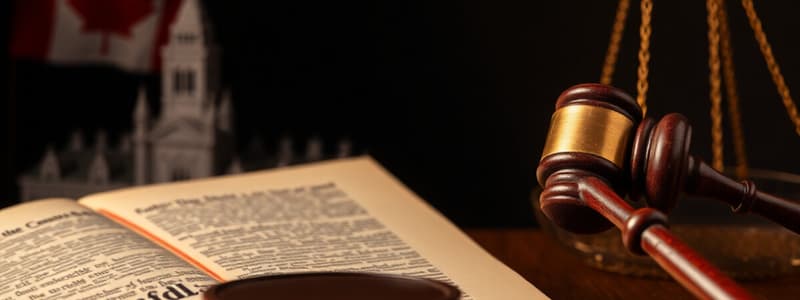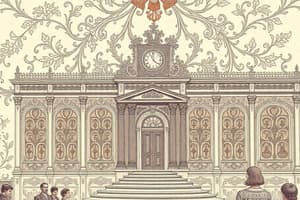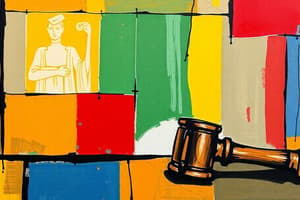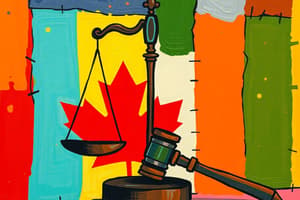Podcast
Questions and Answers
Which of the following is the most accurate description of the role of 'precedence' in the Canadian common law system?
Which of the following is the most accurate description of the role of 'precedence' in the Canadian common law system?
- Statutes passed by legislatures always take precedence over previous court decisions.
- Judges are free to disregard past decisions if they believe those decisions were unjust.
- Judges must respect decisions of higher courts in similar cases when making their rulings. (correct)
- Precedence is only relevant in cases involving federal law, not provincial law.
In a court case, what is the key difference between the ratio decidendi and obiter dicta?
In a court case, what is the key difference between the ratio decidendi and obiter dicta?
- The *ratio decidendi* is the part of the judgment that establishes the legal principle, while *obiter dicta* are non-binding, additional comments. (correct)
- The *ratio decidendi* is the procedural history of the case, while the *obiter dicta* is the legal reasoning.
- *Obiter dicta* are binding on future courts, whereas the *ratio decidendi* is merely persuasive.
- The *ratio decidendi* represents the dissenting opinion, while the *obiter dicta* reflects the majority view.
How do historic treaties in Canada differ significantly from modern treaties with Indigenous peoples?
How do historic treaties in Canada differ significantly from modern treaties with Indigenous peoples?
- Historic treaties often involved an imbalance of power and a lack of understanding, while modern treaties aim for fair negotiation. (correct)
- Historic treaties were primarily focused on land claims, whereas modern treaties address self-government.
- Modern treaties are considered less authoritative sources of law than historic treaties.
- Modern treaties are exclusively negotiated in oral tradition, unlike historic treaties.
Why is customary law considered a less prominent source of law in Canada compared to legislation and case law?
Why is customary law considered a less prominent source of law in Canada compared to legislation and case law?
What role does the King's representative (Governor General) play in the enactment of statutes and legislation in Canada?
What role does the King's representative (Governor General) play in the enactment of statutes and legislation in Canada?
How does increasing complexity in law influence the reliance on expert witnesses in legal proceedings?
How does increasing complexity in law influence the reliance on expert witnesses in legal proceedings?
Which statement accurately reflects a key difference between Indigenous sources of law and Canadian legal traditions?
Which statement accurately reflects a key difference between Indigenous sources of law and Canadian legal traditions?
Sacred law is cited as one of the five sources of Indigenous law. Where does sacred law originate?
Sacred law is cited as one of the five sources of Indigenous law. Where does sacred law originate?
Which factor most directly prompted the creation of a federal system with distinct provincial powers in Canada?
Which factor most directly prompted the creation of a federal system with distinct provincial powers in Canada?
How does the existence of legal pluralism affect the Canadian legal system?
How does the existence of legal pluralism affect the Canadian legal system?
In the context of Canadian law, which statement best describes the relationship between substantive and procedural law?
In the context of Canadian law, which statement best describes the relationship between substantive and procedural law?
Which of the following reflects an instance where international law most directly intersects with Canadian domestic law?
Which of the following reflects an instance where international law most directly intersects with Canadian domestic law?
How did the Magna Carta (1215) influence the development of legal systems?
How did the Magna Carta (1215) influence the development of legal systems?
Which of the following areas of law would primarily address disputes between private citizens or entities, rather than involving the state directly?
Which of the following areas of law would primarily address disputes between private citizens or entities, rather than involving the state directly?
Which of the following statements best describes how technology influences both public and private law?
Which of the following statements best describes how technology influences both public and private law?
A new environmental regulation is enacted that affects how a private company disposes of industrial waste. Which areas of law would this potentially involve?
A new environmental regulation is enacted that affects how a private company disposes of industrial waste. Which areas of law would this potentially involve?
Flashcards
Dynamic Nature of Law
Dynamic Nature of Law
A principle stating that law is not static but constantly changing.
Magna Carta (1215)
Magna Carta (1215)
A foundational document limiting the monarch's power, establishing principles of due process.
Legal Pluralism
Legal Pluralism
The coexistence of multiple legal systems within a single political or legal order.
Public Law
Public Law
Signup and view all the flashcards
Private Law
Private Law
Signup and view all the flashcards
Substantive Law
Substantive Law
Signup and view all the flashcards
Procedural Law
Procedural Law
Signup and view all the flashcards
Charter of Rights and Freedoms (1982)
Charter of Rights and Freedoms (1982)
Signup and view all the flashcards
Legislation
Legislation
Signup and view all the flashcards
Case Law
Case Law
Signup and view all the flashcards
Customary Law
Customary Law
Signup and view all the flashcards
Authoritative Publications
Authoritative Publications
Signup and view all the flashcards
Ratio Decidendi
Ratio Decidendi
Signup and view all the flashcards
Obiter Dicta
Obiter Dicta
Signup and view all the flashcards
Treaties
Treaties
Signup and view all the flashcards
Sacred Law
Sacred Law
Signup and view all the flashcards
Study Notes
- Law is not fixed; it is constantly evolving, which poses challenges to legal theories.
Changes in Law
- Changes in law include prohibition on drugs, medically assisted dying, and death penalty prohibition
- The Charter contributes to law change
- Criminal law's purpose includes restorative/rehabilitative justice, and human rights considerations, not just punishment.
Early Sources
- The Magna Carta (1215) was the first shift from monarchy to more democratic rule, although power remained with powerful barons.
- The feudal system lasted in Canada until 1666.
- Early law in Canada featured colonial law overlapping with Indigenous law (legal pluralism).
Canadian Legal Foundations
- Canadian legal foundations consist of the Royal Proclamation (1763), Quebec Act (1774), Constitution Act (1791), British North America Act (1867), and Charter of Rights and Freedoms (1982).
- The background factors include fear of American expansion and railroads.
- Regional diversity led to Canada becoming a federation with provinces, and included division of powers in Constitution.
- Canadian Legal Context includes: Settler Law, imperfect classification, and important interactions and overlaps between domestic and international law.
Substantive Law and Procedural Law
- Substantive and procedural laws exist, including cruel and unusual punishment (Charter) and torture (international human rights).
- Procedural law can be substantive.
Public Law and Private Law
- Public and Private laws address private persons and the public.
- Public law: constitutional, criminal, administrative, and taxation law.
- Private law: contract, torts, real estate, corporate, property, family, trusts, and patent law, with overlaps between public and private interests.
Major Influences
- British, French, and U.S. Law
- Western Philosophy includes Judaism and Christianity
- Technology
Legal Pluralism
- Legal Pluralism is when multiple forms of law coexist.
- Two systems can coexist within a political/legal order, such as common and civil law in Canada.
- Colonial powers superimposed legal orders where law existed before colonialism (Indigenous Law).
Sources of Law
- The four main sources of law are legislation, case law, and customary law.
- Legislation is passed by elected officials; Case law has precedence and is common Law.
- Statutes and Legislations are laws made by legislatures and parliament, which are signed off on by the Monarchy's representative (Governor General).
- Authoritative publications (e.g. books) are written and unwritten Law.
Case Law
- Case law, or jurisprudence, is common law in Canada, where judges rely on statutes and past cases.
- There is a hierarchy of courts and respect for precedence, with the SCC as the apex court.
- Case law terms: Ratio decidendi (reason for a case), Obiter dicta (not directly relevant statements), parties involved, plaintiff (brings case), defendant (against whom the case is brought), majority/dissent from the judges.
Treaties
- Treaties are agreements between Indigenous peoples and settler governments that define rights and obligations, including historic and modern treaties.
- Historic treaties were abusive because Indigenous leaders had no way to verify agreements.
- Oral agreements were considered important for Indigenous peoples due to oral tradition.
Custom/ Customary Law
- Custom and Customary Law is the 'original' law derived from behaviors and practices over time and varies culturally.
- In Canada, law was already made concretely law
- Unwritten conventions in the Constitution exist (SCC, Reference re Secession of Quebec, 1998).
Expertise and Authority
- Expertise and Authority comes from books, articles, etc.
- Works of experts: scholars, academics, thinkers, etc. (e.g. Blackstone)
- Expert witnesses: psychologists, doctors, or forensic scientists - increased law complexity means increased reliance on experts.
Indigenous Sources of Law
- Indigenous Sources of Law differ from Canadian legal traditions.
- They are concerned with community safety, fairness and accountability.
Sources of Indigenous Law
- Sacred Law: From the Creator, creation stories, etc.
- Deliberative Law: Processes of persuasion, deliberation, council, and discussion (e.g. talking circles)
- Custom: Practices (developed through repetitive patterns of social interaction), such as marriages and family relations.
- Positive Law: Rules, regulations, teachings by elders/community leaders.
Natural Law:
- Relationship with the physical world
- Nature
- Human interaction Natural laws are not watertight but interact with each other.
Studying That Suits You
Use AI to generate personalized quizzes and flashcards to suit your learning preferences.
Related Documents
Description
Explore the dynamic nature of law and its challenges to legal theories. This includes shifts like drug prohibition and evolving views on criminal justice. Learn about early sources such as the Magna Carta and Canadian legal foundations, from the Royal Proclamation to the Charter of Rights.




